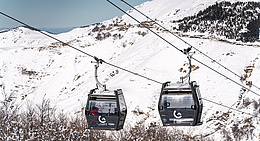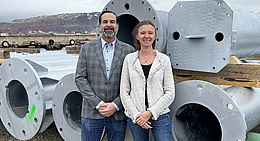All parents know the situation: along a walk or in a hotel, there are places for children to play or things for them to do that they simply love. It is very difficult to get them away from such places. And afterwards they want to go there over and over again. Even after days, they are still not bored with the play activities offered. And then there are playgrounds and playrooms where the kids are at first very excited and cannot get there fast enough, but after a short time they come back and are no longer very interested.
Why is that? What is the difference? Why are some facilities more attractive for children than others? Why do they sometimes find the least spectacular playgrounds so fantastic and lose interest in those with the smartest design after just a few minutes?
It is helpful to consider the offerings in the light of child psychology: What is “great”? What goes down well? What makes kids want to stay?
Why children play
Children play because they are naturally motivated to discover themselves, to develop and strengthen relationships with others, to understand the world around them and to find their way around in it. For children, playing is always about learning. Children play different games, which all help them to see links with their own actions and those of others and to build on them. For children, play is the basis of every learning process; it is their equivalent of work.
Children do not distinguish between playing and learning. Through different forms of play they learn to communicate with the world. Children find playgrounds and related activities particularly interesting when they can learn as much as possible while playing and when multiple forms of play are involved simultaneously.
Ideally, therefore, children should be able to occupy themselves and feel challenged in a variety of ways, with offerings that involve cognitive, sensomotoric or creative challenges and facilitate role-playing.
What forms of play are there?
A really good playground or playroom always provides for several different forms of play. That is important above all because different play activities appeal to different age groups. Some forms of play are particularly relevant in a certain phase of development. They become increasingly complex with increasing age. Especially for role play in interaction with other children and for rule based games, children need the skills appropriate to their age group such as a certain vocabulary and powers of self-expression, the ability to understand rules, frustration tolerance, and gross and fine motor skills.
From about the age of two, specialisation sets in with regard to the games played. Boys tend to prefer interlocking and construction games (Lego) while girls enjoy role play (cooking, Mothers and Fathers, horses, dolls). The toy companies offer gender-specific toys and thus reinforce this trend.
Developmental psychologists and play educationalists distinguish between the following forms of play:
1. Sensomotoric play (functional games)
Sensomotorics relates to all processes in which the sensory organs and the body interact and the perceptual impressions are linked to corresponding motor actions. Sensomotoric play is very important, especially in the first years of life, as it is through their bodies that children learn to understand their environment. The hand and body become tools of thought. Infants explore the world through teething rings and rattles.
2. Physical play (movement games)
Physical play is about enjoyment of the body in movement. Children explore their limits though their bodies; they strengthen their coordination and train their sense of balance, and their fine and gross motor skills. Young children embark on a learning process through the small slide in the playground or their first climbing frame. Older children are already more daring – on a high ropes course, in a soft play area or on a high slide.
3. Construction play
Construction play builds directly on and integrates sensomotoric play. Lego is a typical construction game: it trains children’s creativity and imagination as well as their cognitive skills, e.g. when they follow the instructions for assembling a castle. Construction play is also available in the outdoors, where children can make sand castles, caves, towers, houses, mountains, path boundaries, etc.
4. Role play (pretend games)
Children act out something they have experienced or imagined, either themselves or with the help of dolls or toys. Children play Mothers and Fathers at an early age. Girls in particular develop imaginative role play situations, while boys like to play Pirates or Superhero. Children thus imitate the roles or patterns of behaviour of people in their environment. Role play is encouraged when the game has a storyline, which is brought to life though the game and can be further developed by the child. It is more interesting to climb on a pirate ship than on an ordinary climbing frame, because the game is enriched by the “I am a pirate” role play experience.
5. Rule based games
Rule based games require a certain level of understanding of rules and strategy. Frustration tolerance must also be developed, as such games usually have a winner and a loser. Simple rule games (tile-laying games like Orchard) for young children are not unlike games of chance. It is not until the age of about seven that children reach the stage of mental development where they can understand strategies. Soccer is a rule based game, combined with physical movement of course.
6. Reception games
This term relates to passive forms of play, i.e. viewing (theatre, television, cinema) and listening (stories, music, radio plays). They have a learning function in that they serve to expand the child’s repertoire of language and knowledge. Children between the ages of seven and twelve are particularly interested in knowledge games.
Variety is the spice of play!
If you want to provide play facilities – playgrounds, playrooms or adventure stations – be sure to include as many different types of games as possible. Children always want to play more and longer where they find multiple opportunities for play (= opportunities for learning). For role playing games in particular, you need a good storyline as the basis of your offering.
![[Translate to English:] Foto: shutterstock](/fileadmin/_processed_/9/d/csm_shutterstock_125871545_049a5d35e9.jpg)


![[Translate to English:] (c) Doppelmayr](/fileadmin/_processed_/b/3/csm_85-ATW_Stechelberg-Muerren_Lauterbrunnen_CHE_001_6442c0520d.jpg)








